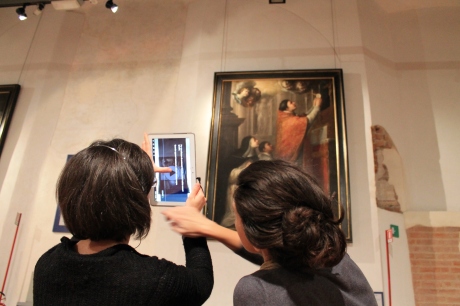Rethinking Religion Representation in Museums: The MeLa Action at Museo Diocesano in Milan
This Experimental Action is intended with the aim of exploiting the religious assets as a potential inter-cultural heritage by the use of digital technologies. The main objective of this experience is to test three conceptual models through which museums could improve their ability in inviting people to deal with diversity issues; these models – multi-cultural storytelling, inter-cultural dialogue, trans-cultural practice – are intertwined with the possibilities provided by multimedia and digital technologies and devices, through the special focus on the mise en scene of the religious questions – discussing on religion, discussing among religions and discussing through religion: contesting, undermining religious identities or confronting, dialoguing about religious diversities and friction
The first pilot test of this Experimental Action took place on October 15th; it consisted in a guided “experience” of ad hoc conceived contents concerning 5 paintings selected within the collection of the museums by a group of 15 “expert visitors” (such as museum curators, theologians, priests, religious of different religions, cultural mediators). The paintings are located in the Sala dell’Arciconfraternita and illustrate the miracles related to Eucharist. The test proposed a different approach to the contents of these artworks, this is, a parallel path to the artistic interpretation curated by the museum, aimed at opening the discussion on a wider cultural sphere, and at suggesting a reflection on different topics associated to the miracles, which may possibly foster transversal considerations among diverse religions (e.g. pilgrimage, disease, faith, pain, safety, intercession, etc.). The experience has been supported with “video animation” and a digital platform accessible by portable tablets: both digital tools have been designed to stimulate multifaceted interpretations, to enable comments and contributions, and to possibly encourage confrontation among the visitors.
During the test, the tablets recognized the paintings and activated the related contents by simply approaching and framing the works of art. These devices guided the “expert users” through the three steps composing the experimented model: listen – interpret – contribute. Initially, they listened and viewed the video animation, finalised at narrating the miracles, introducing a specific topic and focusing details like religious objects, gestures, places and symbols, which may be meaningful for the topic or suitable to make connection and to widen the reflection. Secondly, they were invited to conduct a personal interpretation of the topic associated to the painting, using their own background to answer individually to a structured questionnaire, with the aim of creating a multivocal and multiperspective interpretation through the gathering of the outcomes from all the participants. Finally, they were invited to complement their interpretation by providing references to other works of art, literature or iconography.
These contents, gathered, analysed and critically evaluated in collaboration with the museum curators, will be used for a second pilot test addressing the generic public, with the objective to widen the public of the museum. Thereafter, a first prototype will be developed for making the Museo Diocesano a place for inter-cultural dialogue. In the second test, the experience will be designed in order to offer augmented and multiple points of view on the contents, in relation to a multi-cultural and not-specialised public, looking for a more active and participative interaction.
The prototype and second pilot test are expected to be concluded in Spring 2014.
See more from: Mela blog

